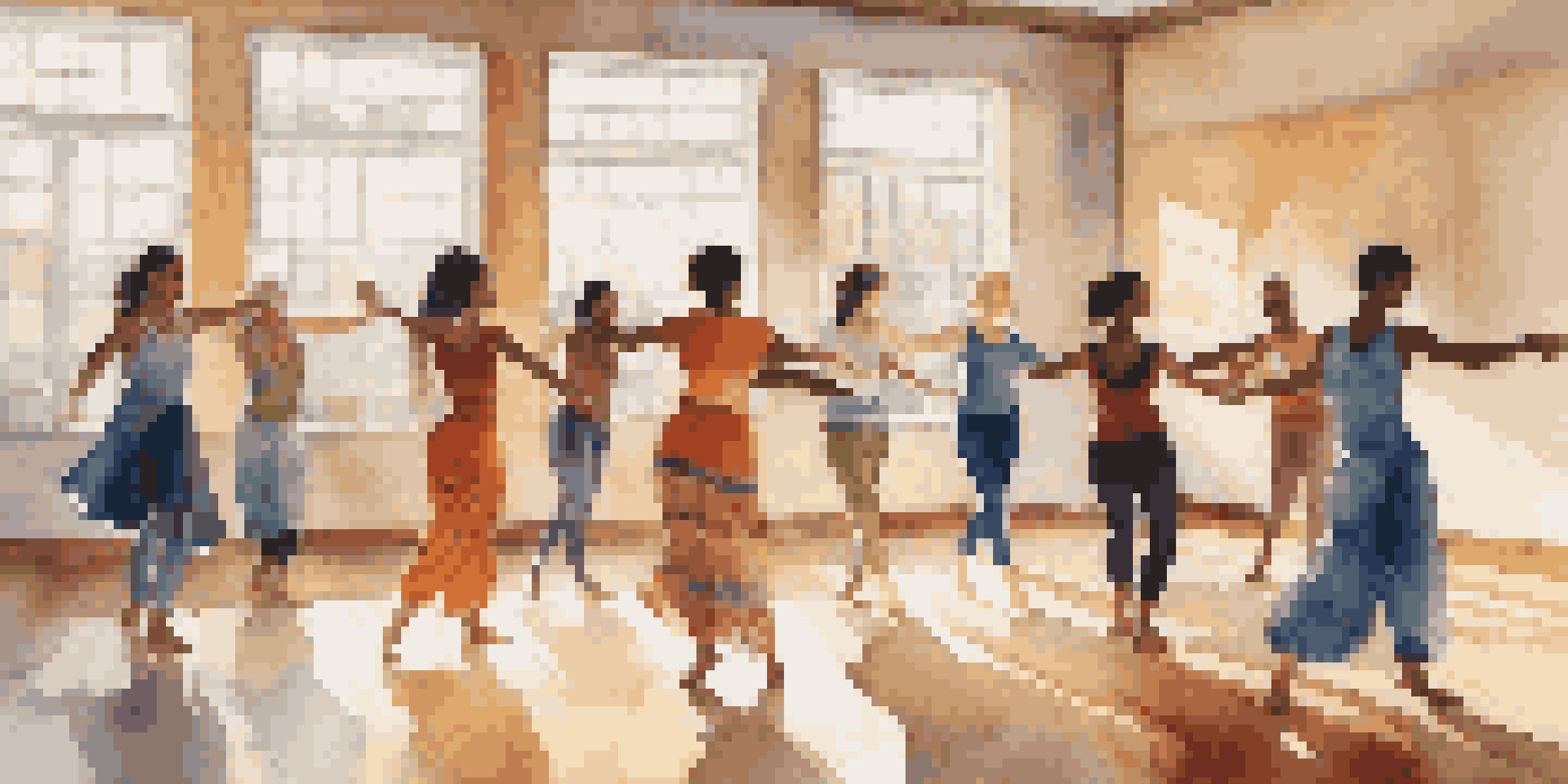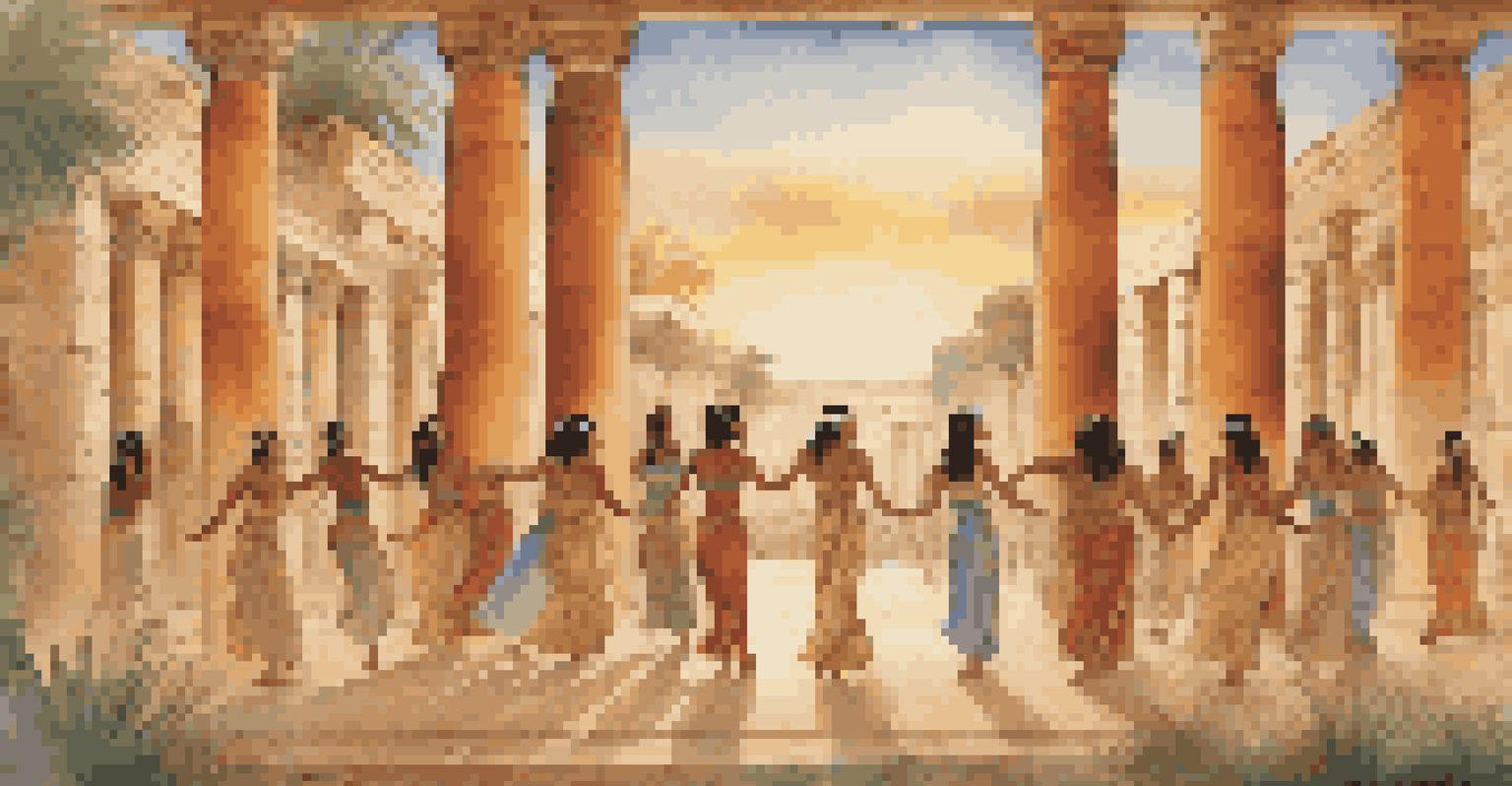The Evolution of Dance Therapy: Healing Through Movement History

Understanding Dance Therapy: An Overview
Dance therapy, or dance/movement therapy (DMT), is a therapeutic practice that uses movement to support emotional, cognitive, and physical integration. It invites individuals to express themselves through dance, tapping into their body’s innate wisdom. This form of therapy can be especially beneficial for those who find it difficult to articulate their feelings verbally.
Dance is the hidden language of the soul.
The roots of dance therapy can be traced back to the early 20th century, when pioneers recognized the healing potential of movement. By combining principles from psychology and the expressive arts, they aimed to create a safe space for individuals to explore their emotions. This holistic approach allows for a deeper connection between mind and body.
Today, dance therapy is recognized not just as a creative outlet, but as a legitimate form of therapeutic intervention. It is employed in various settings, including hospitals, schools, and rehabilitation centers, showcasing its versatility in addressing a wide range of mental and physical health issues.
The Historical Roots of Dance and Healing
Dance has long been intertwined with healing practices across cultures. Ancient civilizations, such as the Greeks and Egyptians, used dance as part of religious rituals and healing ceremonies. These practices emphasized the belief that movement could influence emotional and spiritual well-being.

In the 19th and early 20th centuries, the connection between movement and mental health began to gain more academic attention. Influential figures like Rudolf von Laban explored the expressive nature of movement, laying the groundwork for what would later become dance therapy. His work highlighted how dance could serve as a non-verbal communication tool, bridging gaps in emotional expression.
Dance Therapy Enhances Emotional Healing
Dance therapy utilizes movement to help individuals express emotions that are often difficult to articulate verbally.
These historical practices paved the way for the formalization of dance therapy in the mid-20th century. As psychology and the arts began to intersect, the therapeutic community recognized the need for a structured approach that embraced movement as a valid form of expression and healing.
Key Figures in the Development of Dance Therapy
Several key figures have shaped the field of dance therapy, bringing their unique perspectives and expertise. Among them, Marian Chace is often credited as a founding figure. She integrated dance into mental health treatment in the 1940s, emphasizing its ability to foster communication and self-awareness.
Movement never lies. It is a barometer telling the state of the soul's weather.
Another notable pioneer, Trudi Schoop, expanded the practice further by using dance to treat emotional trauma and promote healing. Her innovative techniques focused on exploring movement as a means of self-discovery, allowing clients to connect with their feelings in a profound way.
These visionaries, along with many others, established the foundations for modern dance therapy, inspiring a new generation of therapists. Their contributions have not only validated the practice but have also encouraged ongoing research into its effectiveness in various therapeutic settings.
The 1960s and 1970s: Formalizing Dance Therapy
The 1960s and 1970s marked a significant turning point for dance therapy, as it began to gain recognition as a formal discipline. This era saw the establishment of organizations such as the American Dance Therapy Association (ADTA), which aimed to promote the practice and provide professional standards.
During this period, more therapists began integrating dance into their work, leading to the development of various techniques and methodologies. The growing interest in holistic health and alternative therapies also contributed to the popularity of dance therapy, as people sought new ways to heal.
Historical Roots Influence Modern Practice
The origins of dance therapy can be traced back to ancient healing practices, evolving through key figures and formal recognition in the mid-20th century.
Research began to emerge, supporting the efficacy of dance therapy in treating conditions like depression, anxiety, and trauma. This growing body of evidence helped to legitimize dance therapy within the broader mental health community, attracting more practitioners and clients alike.
The Role of Movement in Emotional Expression
At the heart of dance therapy lies the understanding that movement can be a powerful vehicle for emotional expression. Many individuals find it challenging to articulate their feelings, but through movement, they can tap into deeper layers of their psyche. This non-verbal communication allows for a more authentic exploration of emotions.
For instance, a person struggling with grief may find that certain movements, like flowing gestures, can help them express their sorrow more fully than words ever could. This process can lead to catharsis and healing, as clients learn to embrace their feelings without judgment.
Additionally, movement can promote body awareness, helping individuals reconnect with their physical selves. This heightened awareness often encourages clients to understand how their emotions manifest in their bodies, leading to greater insight and healing.
Current Trends and Innovations in Dance Therapy
As we move further into the 21st century, dance therapy continues to evolve, incorporating new techniques and technologies. One notable trend is the integration of mindfulness practices into dance therapy sessions. Mindfulness encourages clients to be present in their bodies, enhancing the therapeutic experience.
Another innovation is the use of technology, such as virtual reality and online platforms, which have made dance therapy accessible to a broader audience. This shift became particularly important during the pandemic, allowing individuals to engage in therapeutic practices from the comfort of their homes.
Future Trends Embrace Holistic Approaches
As dance therapy evolves, it increasingly incorporates mindfulness and technology, expanding its reach and effectiveness in various settings.
Moreover, contemporary dance therapy is increasingly being recognized in diverse settings, from schools to corporate environments. This broader application highlights the versatility of dance therapy in addressing a range of issues, from stress management to team building.
The Future of Dance Therapy: A Holistic Approach
Looking ahead, the future of dance therapy seems promising, with a growing recognition of its holistic benefits. As more research supports the effectiveness of movement in mental health treatment, we can expect to see an increase in its integration within traditional therapeutic practices.
The emphasis on holistic health is also driving interest in combining dance therapy with other modalities, such as art therapy and yoga. This interdisciplinary approach allows for a more comprehensive treatment plan, catering to the unique needs of each individual.

Ultimately, as society continues to embrace the importance of mental well-being, dance therapy will likely play a vital role in promoting healing and self-expression. By honoring the mind-body connection, it offers a unique and powerful avenue for personal growth and emotional resilience.